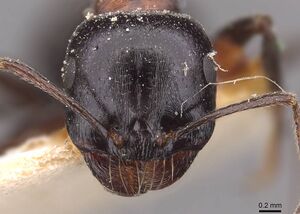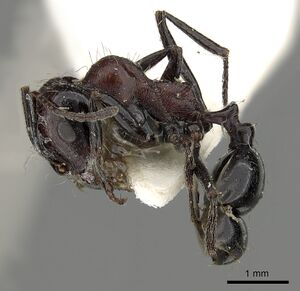Messor medioruber
| Messor medioruber | |
|---|---|

| |
| Scientific classification | |
| Kingdom: | Animalia |
| Phylum: | Arthropoda |
| Class: | Insecta |
| Order: | Hymenoptera |
| Family: | Formicidae |
| Subfamily: | Myrmicinae |
| Tribe: | Stenammini |
| Genus: | Messor |
| Species: | M. medioruber |
| Binomial name | |
| Messor medioruber Santschi, 1910 | |
| Subspecies | |
| |
| Synonyms | |
| |
Identification
Collingwood and Agosti (1996) - HW 2.0; EL/HW 0.245. This bicoloured species differs from Messor meridionalis by the numerous dorsal hairs over the alitrunk and gaster and the shape of the postpetiole which has a flat ventral surface without a protruding process when viewed in full profile.
Distribution
Latitudinal Distribution Pattern
Latitudinal Range: 36.816667° to 21.133333°.
| North Temperate |
North Subtropical |
Tropical | South Subtropical |
South Temperate |
- Source: AntMaps
Distribution based on Regional Taxon Lists
Afrotropical Region: Saudi Arabia, United Arab Emirates.
Palaearctic Region: Algeria, Iran, Iraq, Kuwait, Morocco, Tunisia (type locality).
It is known to occur in North Africa, Saudi Arabia and Iraq (Abdul-Rassoul et al. 2013).
Distribution based on AntMaps
Distribution based on AntWeb specimens
Check data from AntWeb
Countries Occupied
| Number of countries occupied by this species based on AntWiki Regional Taxon Lists. In general, fewer countries occupied indicates a narrower range, while more countries indicates a more widespread species. |

|
Estimated Abundance
| Relative abundance based on number of AntMaps records per species (this species within the purple bar). Fewer records (to the left) indicates a less abundant/encountered species while more records (to the right) indicates more abundant/encountered species. |

|
Biology
Castes
Worker
Images from AntWeb
   
| |
| Syntype of Messor medioruber. Worker. Specimen code casent0907723. Photographer Z. Lieberman, uploaded by California Academy of Sciences. | Owned by MHNG, Geneva, Switzerland. |
   
| |
| Worker. Specimen code casent0249828. Photographer Ryan Perry, uploaded by California Academy of Sciences. | Owned by NHMB, Basel, Switzerland. |

| |
| Worker. Specimen code casent0249827. Photographer Ryan Perry, uploaded by California Academy of Sciences. | Owned by NHMB, Basel, Switzerland. |
Nomenclature
The following information is derived from Barry Bolton's Online Catalogue of the Ants of the World.
- medioruber. Messor barbarus st. mediorubra Santschi, 1910a: 44.
- Type-material: syntype workers (number not stated), 1 syntype queen.
- Type-locality: Tunisia: Kairouan (F. Santschi).
- Type-depository: MHNG.
- [First available use of Stenamma (Messor) barbarum r. capitatum var. mediorubra Forel, 1905b: 176 (w.q.m.) TUNISIA; unavailable (infrasubspecific) name.]
- [Misspelled as mediorufa by Santschi, 1908: 518, Finzi, 1940: 159, and others.]
- As unavailable (infrasubspecific) name: Emery, 1908e: 450; Santschi, 1908: 518; Emery, 1912f: 98; Emery, 1921f: 71; Emery, 1922c: 94; Viehmeyer, 1923: 87; Emery, 1924a: 8.
- Subspecies of barbarus: Karavaiev, 1912a: 9; Santschi, 1917e: 92.
- Subspecies of instabilis: Santschi, 1923f: 325; Finzi, 1940: 159; Cagniant, 1964: 87; Cagniant, 1966b: 279.
- Subspecies of minor: Santschi, 1927c: 237 (redescription).
- Status as species: Cagniant, 1968a: 143; Cagniant, 1970a: 415; Bernard, 1971: 7; Collingwood, 1985: 251; Bolton, 1995b: 255; Collingwood & Agosti, 1996: 318; Cagniant & Espadaler, 1998: 426; Cagniant, 2006a: 197; Collingwood, et al. 2011: 426; Borowiec, L. 2014: 108 (see note in bibliography); Barech, et al. 2020: 16.
- Senior synonym of sublaeviceps: Cagniant & Espadaler, 1998: 426.
- Distribution: Algeria, Kuwait, Tunisia, United Arab Emirates.
- Current subspecies: nominal plus montanus.
- sublaeviceps. Messor sublaeviceps Santschi, 1927c: 241.
- Type-material: syntype workers (number not stated).
- Type-locality: Israel (“Syria”): Jerusalem.
- Type-depository: NHMB.
- [First available use of Messor barbarus st. mediorubra var. sublaeviceps Santschi, 1910a: 45 (w.q.) TUNISIA; unavailable (infrasubspecific) name.]
- As unavailable (infrasubspecific) name: Emery, 1912f: 98; Santschi, 1917e: 90.
- [Note: Santschi, 1917e: 90, Emery, 1921f: 71, refer sublaeviceps material to meridionalis.]
- Status as species: Santschi, 1927c: 241 (redescription); Santschi, 1939d: 71; Finzi, 1940: 159.
- Subspecies of medioruber: Cagniant, 1970a: 416; Bolton, 1995b: 257.
- Junior synonym of instabilis: Bernard, 1953a: 141 (in text).
- Junior synonym of medioruber: Cagniant & Espadaler, 1998: 426.
Description
References
- Abdi-Hamecha, L., Barech, G., Khaldi, M., Sadoudi, D. A.-A., Salem, S., Zazgad, I., Cagniant, H. 2021. Diversité des fourmis (Hymenoptera, Formicidae) dans la forêt de Yakouren (Algérie) : Estimation de la richesse, biogéographie et taxonomie. Revue Suisse de Zoologie, 128(1), 61-72 (doi:10.35929/rsz.0035).
- Abdul-Rassoul, M.S., Ali, H.B. & Augul, R.SH. 2013. New Records of Unidentified Ants worker (Hymenoptera: Formicidae: Myrmicinae) stored in Iraqi Natural History Museum with key to Species. Adv. Biores., Vol 4 (2): 27-33.
- Barech, G., Khaldi, M., Espadaler, X., Cagniant, H. 2020. Révision taxonomique du genre Messor (Hymenoptera, Formicidae) au Maghreb et description de Messor hodnii sp. n., une nouvelle espèce de fourmi trouvée en Algérie. Revue suisse de Zoologie 127(1) : 9-19 (doi:10.35929/RSZ.0002).
- Borowiec, L. 2014. Catalogue of ants of Europe, the Mediterranean Basin and adjacent regions (Hymenoptera: Formicidae). Genus (Wroclaw) 25(1-2): 1-340.
- Cagniant, H. 1968a. Liste préliminaire de fourmis forestières d'Algérie. Résultats obtenus de 1963 à 1966. Bull. Soc. Hist. Nat. Toulouse 104: 138-147 (page 143, Raised to species)
- Cagniant, H. 1970a [1969]. Deuxième liste de fourmis d'Algérie récoltées principalement en forêt. (1re partie). Bull. Soc. Hist. Nat. Toulouse 105: 405-430 (page 415, Raised to species)
- Cagniant, H.; Espadaler, X. 1998 [1997]. Le genre Messor au Maroc (Hymenoptera: Formicidae). Ann. Soc. Entomol. Fr. (n.s.) 33: 419-434 (page 426, Senior synonym of sublaeviceps)
- Collingwood, C. A. and D. Agosti. 1996. Formicidae (Insecta: Hymenoptera) of Saudi Arabia (part 2). Fauna Saudi Arabia. 15:300-385.
- Collingwood, C.A., Agosti, D., Sharaf, M.R., van Harten, A. 2011. Order Hymenoptera, family Formicidae. Arthropod fauna of the UAE 4: 405-474.
- Forel, A. 1905e. Miscellanea myrmécologiques II (1905). Ann. Soc. Entomol. Belg. 49: 155-185 (page 176, First available use of Stenamma (Messor) barbarum r. capitatum var. mediorubra; unavailable name.)
- Santschi, F. 1910a. Nouvelles fourmis de Tunisie (3e note). Bull. Soc. Hist. Nat. Afr. Nord 1: 43-46 (page 44, worker, queen, male described)
- Santschi, F. 1923f. Messor et autres fourmis paléarctiques. Rev. Suisse Zool. 30: 317-336 (page 325, Stirps of instabilis)
- Santschi, F. 1927d. Revision des Messor du groupe instabilis Sm. (Hymenopt.). Bol. R. Soc. Esp. Hist. Nat. 27: 225-250 (page 237, Stirps of minor)
References based on Global Ant Biodiversity Informatics
- Barech G., M. Khaldi, S. Ziane, A. Zedam, S. Doumadji, M. Sharaf, and X. Espadaler. 2016. A first checklist and diversity of ants (Hymenoptera: Formicidae) of the saline dry lake Chott El Hodna in Algeria, a Ramsar Conservation Wetland. African Entomology 24(1): 143–152.
- Borowiec L. 2014. Catalogue of ants of Europe, the Mediterranean Basin and adjacent regions (Hymenoptera: Formicidae). Genus (Wroclaw) 25(1-2): 1-340.
- Bouzekri M. A. 2011. Bioecologie des Formicidae dans la region de Djelfa: nidification et relation avec les plantes. Mphil Ecole National Superieure agronomique. 153pp.
- Bouzekri M., S. Daoudi-Hacini, H. Cagniant, and S. E. Doumandji. 2015. Etude comparative des associations (plantes-fourmis) dans une region steppique (cas de la region de Djelfa, Algerie). Lebanese Science Journal 16(1): 69-77.
- Cagniant, H., and X. Espadaler. "Le genre Messor au Maroc." Annales de la Société Entomologique de France (N.S.) 33 (4) (1998): 419-434.
- Cagniant, H.. "Contribution à la connaissance des fourmis marocaines: Aphaenogaster atlantis Santschi, 1929 bona species (n. status) (Hymenoptera, Formicidae, Myrmicinae)." Bulletin du Muséum National d'Histoire Naturelle Section A Zoologie, Biologia et Écologie Animales (4)12 (1990): 123-133.
- Cagniant, H.. "Deuxième liste de fourmis d'Algérie récoltées principalement en forêt. (1re partie)." Bulletin de la Société d'Histoire Naturelle de Toulouse 105 (1970): 405-430.
- Cagniant, H.. "Liste préliminaire de fourmis forestières d'Algérie. Résultats obtenus de 1963 à 1966." Bulletin de la Societe d'Histoire Naturelle de Toulouse 104 (1968): 138-147.
- Cagniant, H.. "Note sur le peuplement en fourmis d'une montagne de la région d'Alger, l'Atlas de Blida." Bulletin de la Société d'Histoire Naturelle de Toulouse 102 (1966): 278-284.
- Cagniant, H.. Les peuplements de fourmis des forêts algériennes: écologie, biocénotique, essai biologique. Universite de Toulouse, 1973.
- Chemala A., M. Benhamacha, D. M. Ould el Hadj, F. Marniche, and S. Daoudi. 2017. A preliminary list of the ant fauna in Northeastern Sahara of Algeria (Hymenoptera: Formicidae). Sociobiology 64(2): 146-154.
- Collingwood C. A., D. Agosti, M. R. Sharaf, A. Van Harten, 2011. Order Hymenoptera, family Formicidae. Arthropod Fauna of the UAE 4: 405-474
- Collingwood C.A., D.Agosti, M.R. Sharaf, and A. van Harten. 2011. Order Hymenoptera, family Formicidae. Arthropod fauna of the UAE, 4: 405474
- Delye, G., and J. L. Bonaric. "Fourmis du sud Marocain." Etude de certains milieux du Maroc et de leux evolution recente RCP 249 (1973).
- Emery, C.. "Beiträge zur Monographie der Formiciden des paläarktischen Faunengebietes. (Hym.) Teil III. Messor, Goniomma, Oxyopomyrmex." Deutsche Entomologische Zeitschrift 1908 (1908): 437-465.
- Forel A. 1905. Miscellanea myrmécologiques II (1905). Ann. Soc. Entomol. Belg. 49: 155-185.
- Forel, A.. "Miscellanea myrmécologiques II (1905)." Annales de la Société Entomologique de Belgique 49 (1905): 155-185.
- Ghahari H., C. A. Collingwood, M. Tabari, and H. Ostovan. 2009. Faunistic notes on Formicidae (Insecta: Hymenoptera) of rice fields and surrounding grasslands in northern Iran. Mun. Ent. Zool. 4(1): 184-189.
- Menozzi C. 1934. Reperti mirmecofaunistici raccolti dal Prof. L di Caporiacco nelle oasi di Cufra e in altre localita del deserto Libico. Atti della Societa dei Naturalisti e Matematici di Modena (6)13(65): 153-166
- Santschi, F. 1927. Révision des Messor du groupe instabilis Sm. (Hymenopt.). Boletin de la Real Sociedad Española de Historia Natural 27: 225-250.
- Santschi, F.. "Nouvelles fourmis de Tunisie (3e note)." Bulletin de la Société d' Histoire naturelle de l' Afrique du Nord 1 (1910): 43-46.
- Santschi, F.. "Revision des Messor du groupe instabilis Sm. (Hymenopt.)." Boletín de la Real Sociedad española de Historia natural (Madrid) 27 (1927): 225-250.
- Santschi, F. 1910. Nouvelles fourmis de Tunisie (3e note). Bulletin de la Société d'Histoire Naturelle de l'Afrique du Nord 1: 43-46.
- Viehmeyer H. 1923. Wissenschaftliche Ergebnisse der mit Unterstützung der Akademie der Wissenschaften in Wien aus der Erbschaft Treitl von F. Werner unternommenen zoologischen Expedition nach dem anglo-ägyptischen Sudan (Kordofan) 1914. VII. Hymenoptera A. Formicidae. Denkschriften der Akademie der Wissenschaften in Wien. Mathematisch-Naturwissenschaftliche Klasse 98: 83-94.

